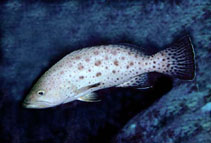| Family: |
Epinephelidae (Groupers) |
| Max. size: |
105 cm TL (male/unsexed); max.weight: 14 kg |
| Environment: |
reef-associated; marine; depth range 8 - 55 m |
| Distribution: |
Eastern Central Pacific: Gulf of California south to Jalisco, Mexico. |
| Diagnosis: |
Dorsal spines (total): 11-11; Dorsal soft rays (total): 16-18; Anal spines: 3-3; Anal soft rays: 10-12. Distinguished by the following characteristics: adults with pale grey to brown with purplish tint underwater; body, median fins and rear part of the head covered with small dark reddish brown spots; faint irregular dark spots on dusky pectoral and pelvic fins; dusky blotches on the dorsolateral part of the body; angular preopercle, with serrate lobe at the angle; posterior nostrils not greatly enlarged in adults; rear margin of caudal fin scalloped, with exserted rays (Ref. 89707). |
| Biology: |
Found on rocky reefs. Common on fields of large boulders with gorgonians and black corals. Feeds on fishes and crustaceans (Ref. 89707). |
| IUCN Red List Status: |
Data deficient (DD); Date assessed: 18 November 2016 Ref. (130435)
|
| Threat to humans: |
harmless |
Source and more info: www.fishbase.org. For personal, classroom, and other internal use only. Not for publication.
